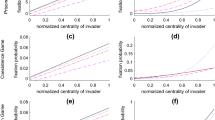Abstract
This paper researches the nonlinear dynamics of the behavior selection networks (BSN) model by virtue of which we can understand the origin of flocking behaviors in social networks. To commentate the notion of BSN, this article introduces a social behavior selection model for evolutionary dynamics of behaviors in social networks that exhibits a rich set of emergent behaviors of evolution. For behavioral networks with different complex networks topology, we analyze the nonlinear dynamics including the chaotic dynamics by the numerical simulation tools. With changing the topological structure, the behavioral networks behave affluent dynamical phenomena. Lastly, we draw the conclusion and paste the prospection about the networks model.
Similar content being viewed by others
References
Shendarkar, A., Vasudevan, K., Lee, S., Son, Y.J.: Crowd simulation for emergency response using BDI agent based on virtual reality. In: Perrone, L.F., Wieland, F.P., Liu, J., Lawson, B.G., Nicol, D.M., Fujimoto, R.M. (eds.) Proceedings of the 2006 Winter Simulation Conference, pp. 545–553. Institute of Electrical and Electronics Engineers, Piscataway, NJ (2006)
Helbing, D., Farkas, I., Vicsek, T.: Simulating dynamical features of escape panic. Nature 407(28), 487–490 (2000)
Musse, S.R., Thalmann, D.: Hierachical model for real time simulation of virtual human crowds. IEEE Trans. Vis. Comput. Graph. 7(2), 152–164 (2001)
Hodgins, J., Brogan, D.: Group behaviors for systems with significant dynamics. Auton. Robots 4, 137–153 (1997)
Bouvier, E., Guilloteau, P.: Crowd simulation in immersive space management. In: Proceedings of the Eurographics Workshop on Virtual Environments and Scientific Visualization’96, pp. 104–110. Springer, London (1996)
Braun, A., Musse, S.R., de Oliveira, L.P.L., Bodmann, B.E.J.: Modeling individual behaviors in crowd simulation. In: Computer Animation and Social Agents, 16th International Conference, pp. 143–148, New Brunswick, NJ (2003)
Luo, L., Zhou, S., Cai, W., Malcolm, Tian F., Wang, Y., Xiao, X., Chen, D.: Agent-based human behavior modeling for crowd simulation. Comput. Animat. Virtual Worlds 19(3–4), 271–281 (2008)
Dogbéa, C.: On the numerical solutions of second order macroscopic models of pedestrian flows. Comput. Math. Appl. 56(7), 1884–1898 (2008)
Ivancevic, V.G., Reid, D.J., Aidman, E.V.: Crowd behavior dynamics: entropic path-integral model. Nonlinear Dyn. 59, 351–373 (2010)
Le Bon, G.: The crowd: a study of the popular mind. Macmillan, New York (1946) (English translation of original French version in 1896)
Quek, H.Y., Tan, K.C., Abbass, H.A.: Evolutionary game theoretic approach for modeling civil violence. IEEE Trans. Evol. Comput. 13(4), 780–800 (2009)
Berck, Richard A.: A gaming approach to crowd behavior. Am. Soc. Rev. 39, 355–373 (1974)
Lychagin, V., Lychagina, O.: Finite dimensional dynamics for evolutionary equations. Nonlinear Dyn. 48, 29–48 (2007)
Watts, D.J., Strogatz, S.H.: Collective dynamics of “small-world” networks. Nature 393, 440–442 (1998)
Barabási, A.L., Albert, R.: Emergence of scaling in random networks. Science 286, 509–512 (1999)
Szabó, G., Fáth, G.: Evolutionary games on graphs. Phys. Rep. 446, 97–216 (2007)
Olfati-Saber, R.: Evolutionary dynamics of behavior in Social networks. In: Proceedings of the 46th IEEE Conference on Dicision and Control, pp. 4051–4056, New Orleans, LA (2007)
Yang, Y., Li, X., Rong, Z.: Assortative degree-mixing patterns inhibit behavioral diversity of a scale-free structured population in high-mutation situations. EPL 89, 18006 (2010)
Fu, F., Wang, L.: Coevolutionary dynamics of opinions and networks: from diversity to uniformity. Phys. Rev. E 78, 016104 (2008)
Hussein, I.I.: An individual-based evolutionary dynamics model for networked social behaviors. In: 2009 American Control Conference, pp. 5789–5796, Hyatt Regency Riverfront, St. Louis, MO (2009)
Xu, X., Chen, Z., Si, G., Hu, X., Luo, P.: A novel definition of generalized synchronization on networks and a numerical simulation example. Comput. Math. Appl. 56, 2789–2794 (2008)
Eigen, M., Schuster, P.: The Hypercycle: A Principle of Natural Self-Organization. Springer, London (1979)
Hofbauer, J., Sigmund, K.: Evolutionary Games and Population Dynamics. Cambridge University Press, Cambridge (1998)
Erdös, P., Rényi, A.: On the evolution of random graphs. Publ. Math. Inst. Hung. Acad. Sci. 5, 17–60 (1959)
Batagelj, V., Mrvar, A.: Networks/Pajek, program for large network analysis (2005)
Komarova, N.L.: Replicator–mutator equation, universality property and population dynamics of learning. J. Theor. Biol. 230, 227–239 (2004)
Mitchener, W.G., Nowak, M.A.: Chaos and language. Proc. R. Soc. B 271, 701–704 (2004)
Evan-Iwanowski, R.M., Lu, C.H.: Nonstationary process: nonstationary bifurcation maps, evolutionary dynamics. Nonlinear Dyn. 21(4), 337–352 (2000)
Author information
Authors and Affiliations
Corresponding author
Rights and permissions
About this article
Cite this article
Xu, X., Chen, Z., Si, G. et al. The chaotic dynamics of the social behavior selection networks in crowd simulation. Nonlinear Dyn 64, 117–126 (2011). https://doi.org/10.1007/s11071-010-9850-z
Received:
Accepted:
Published:
Issue Date:
DOI: https://doi.org/10.1007/s11071-010-9850-z




